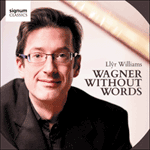Rienzi was Wagner’s first success, but also the last opera he wrote where he did not control the synopsis and libretto completely. Liszt came to his piano work on the opera,
Phantasiestück über Motive aus Rienzi, rather later, and it is his only example of a real operatic fantasy on Wagner (his other Wagnerian homages are really closer to literal transcriptions). Much of the material will be familiar from the overture, but the opening motif of the fantasy, which gives the work its subtitle, ‘Santo spirito cavaliere’, is part of the finale to Act III (Wagner has the motif sung to these Italian words, although the published score has the grammar and spelling somewhat fractured), and the splendid theme of
Rienzi’s Prayer from Act V (also the main theme of the overture) follows. The dramatic contrast and impetus is then provided by the
Call to Arms from the beginning of Act I. The whole piece is an excellent musico-dramatic entity which might be seen as a character portrait of the opera’s hero.
from notes by Leslie Howard © 1994
Rienzi fut le premier succès de Wagner mais aussi le dernier opéra qu’il composa, et il ne parvint pas à en contrôler complètement la synopse et le livret. Liszt composa, quelques temps plus tard, son œuvre pour piano,
Phantasiestück über Motive aus Rienzi, en s’inspirant de cet opéra, œuvre qui est en fait le seul exemple d’une véritable fantaisie opératique tirée de Wagner (ses autres hommages wagnériens se rapprochent plus de transcriptions littérales.) La plupart du matériau est familier dès l’ouverture, mais le motif qui débute la fantaisie et qui donne à l’œuvre son sous-titre, «Santo spirito cavaliere», fait partie du finale de l’acte III (Wagner voulait que le motif soit chanté sur les mots italiens, mais la grammaire et l’orthographe de la partition avaient été quelque peu altérées), et est suivi ensuite par le thème splendide de
La prière de Rienzi de l’acte IV (aussi le thème principal de l’ouverture). Le contraste dramatique, ainsi que le mouvement, sont provoqués par
L’appel aux armes du début de l’acte I. L’œuvre entière est un excellent drame musical qui peut être vu comme étant un portrait du caractère du personnage héroïque de l’opéra.
extrait des notes rédigées par Leslie Howard © 1994
Français: Isabelle Dubois
Rienzi war Wagners erster Erfolg, aber auch die letzte von ihm geschriebene Oper, in der er keine vollständige Kontrolle über Synopsis und Libretto hatte. Liszt kam sehr viel später zu seinem Klavierwerk
Phantasiestücke über Motive aus Rienzi, und es ist das einzige von ihm gelieferte Beispiel für eine echte Opernfantasie über Wagner (seine anderen Würdigungen Wagners sind eher buchstäbliche Transkriptionen). Ein großer Teil des musikalischen Stoffes ist aus der Ouvertüre bekannt, aber das einleitende Motiv der Fantasie, dem das Werk seinen Untertitel „Santo spirito cavaliere“ verdankt, ist ein Teil des Finales zum 3. Akt (bei Wagner wird das Motiv in diesen italienischen Worten gesungen, wenn auch in der veröffentlichten Partitur Grammatik und Rechtschreibung etwas gebrochen erscheinen), und das herrliche Thema von
Rienzis Gebet aus dem 5. Akt (welches auch das Hauptthema der Ouvertüre darstellt) folgt. Dramatischer Kontrast und Impuls werden dann durch den vom Anfang des 1. Aktes stammenden
Ruf zu den Waffen erreicht. Das ganze Stück ist eine vortreffliche musikalisch-dramatische Einheit, die als Charakterschilderung des Helden der Oper gedeutet werden kann.
aus dem Begleittext von Leslie Howard © 1994
Deutsch: Angelika Malbert


 Liszt: Complete Piano Music
Liszt: Complete Piano Music Wagner: Wagner without words
Wagner: Wagner without words
